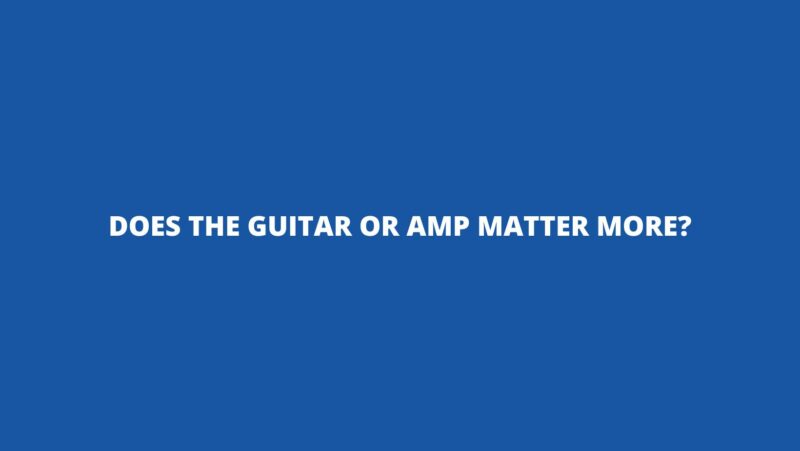In the vast universe of music, the quest for the perfect tone serves as a guiding star for countless musicians. Central to this pursuit lies an age-old question that has ignited debates and discussions in jam rooms, studios, and online forums alike: does the guitar or the amplifier wield more influence in shaping a musician’s tone? This article delves into the heart of this musical dilemma, delving into the individual roles of both the guitar and the amplifier, analyzing their collaborative impact, and examining the contextual factors that define the significance of each in the pursuit of sonic excellence.
The Yin and Yang of Tone: Guitar and Amplifier: Before embarking on the exploration, it’s paramount to acknowledge the distinct and complementary roles played by both the guitar and the amplifier in crafting the final tone.
The Guitar: The guitar serves as the vessel through which an artist’s emotions flow into sound waves. Its construction, woods, pickups, strings, and setup all contribute to the instrument’s inherent tonal signature.
The Amplifier: The amplifier stands as the conduit that transforms the guitar’s electrical signal into audible art. Elements such as preamps, tone controls, gain stages, and power amps work in harmony to amplify, color, and shape the sound.
Factors Influencing Tone:
1. Guitar Factors:
- Pickups: Different pickup types offer distinct tonal qualities, from the clear and airy single-coils to the powerful and warm humbuckers.
- Wood Selection: The wood used in the guitar’s body and neck affects resonance, sustain, and tonal characteristics, contributing to the overall sonic palette.
- Construction and Design: The guitar’s build, including factors like neck joint, body shape, and bridge type, influences sustain, attack, and tonal balance.
- Scale Length: Scale length impacts string tension, affecting the feel of the strings and the instrument’s tonal response.
2. Amplifier Factors:
- Preamp Characteristics: Different amplifier types—such as tube, solid-state, and modeling—impart their own sonic qualities, affecting warmth, compression, and harmonic richness.
- Tone Control Capabilities: Tone controls allow for fine-tuning of the frequency response, enabling players to shape the tonal balance by adjusting bass, midrange, and treble frequencies.
- Gain Stages and Dynamics: Amplifier gain stages introduce distortion or overdrive, influencing the overall tonal color and the dynamic response of the sound.
- Power Amp Influence: The power amp section affects the dynamic feel of the sound, determining how it responds to variations in playing technique.
- Speaker and Cabinet Configuration: Different speakers and cabinet designs impact sound projection, resonance, and spatial characteristics.
The Intricate Dance: Guitar and Amp Interaction:
1. Symbiotic Partnership: The guitar and amplifier share a symbiotic relationship, where the tonal characteristics of one can be enhanced or altered by the qualities of the other.
2. Expressive Dynamics: The guitar interacts with the amplifier, responding to playing nuances. This interaction magnifies the dynamics and touch sensitivity, enabling expressive control over the sound.
3. Collaborative Sonic Shaping: The guitar provides the foundation, while the amplifier offers the canvas for artistic expression. Their combined influence crafts a unique tonal identity.
Considerations in Musical Context:
1. Acoustic vs. Electric: In the realm of acoustic guitars, the instrument itself carries the bulk of the tonal responsibility, while amplifiers don’t play a role. For electric guitars, the amplifier becomes pivotal.
2. Genres and Sound Styles: Certain genres place greater emphasis on either the guitar or the amplifier. Vintage blues and rock often highlight the guitar’s characteristics, while modern metal leans heavily on high-gain amps.
3. Artistic Intention: Some players prioritize the purity of their guitar’s natural sound and invest in high-quality instruments. Others view the amplifier as the primary tool for tone shaping and experimentation.
4. Signature Sounds: Famous guitarists are often closely associated with both their guitar and amplifier choices, contributing to their unique and recognizable tones.
Striking a Harmonious Balance:
1. Crafting Individual Identity: The guitar and amplifier work in unison to create an artist’s sonic identity. A great guitar can sound exceptional through a high-quality amp, and an exceptional amp can enhance the qualities of a great guitar.
2. Exploring Versatility: A versatile amplifier can overcome certain limitations in a guitar’s tonal range. Simultaneously, a flexible guitar can adapt to different amplifier settings, offering a wide array of sonic possibilities.
3. Personal Contextualization: The decision of which factor matters more depends on an artist’s goals, musical style, and intentions. Some prioritize one over the other, while others find a harmonious balance between the two.
Conclusion: The Interwoven Tapestry of Tone: Attempting to determine whether the guitar or the amplifier matters more in tone creation leads us to recognize the complexity of their relationship. It’s not a question of one outweighing the other, but rather of understanding the profound influence they wield in tandem.
The guitar and amplifier engage in a dance of creativity, where each partner’s strengths enhance the other’s contributions. The guitar’s innate characteristics set the foundation, while the amplifier magnifies, colors, and projects those qualities into the sonic realm. Instead of viewing this debate as an either-or situation, musicians can embrace the duality, understanding that the magic truly unfolds when guitar and amp work together in harmony. It’s this synchronicity that allows players to explore the myriad facets of their sonic expression, weaving a unique and intricate tapestry of tone that resonates with their individuality and artistic vision.


